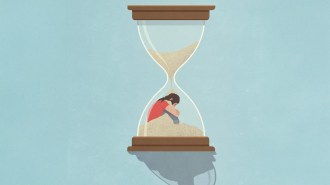Same face, different person
Photos of a stranger's mug can assume many identities to observers
For an instant “identity crisis,” just peruse some photographs of a stranger’s face. In many instances, people view different mug shots of an unfamiliar person as entirely different individuals, say psychologist Rob Jenkins of the University of Glasgow, Scotland, and his colleagues.
Yet photos of a celebrity or other recognizable person retain a uniform identity despite changes in lighting, facial expression and other factors across images, the scientists report in a paper published online September 3 in Cognition.
To better understand issues such as eyewitness memory, and with an eye on creating reliable facial-recognition software, psychologists, vision researchers and computer scientists are studying how people recognize faces of individuals they’ve just seen and faces of those they’ve encountered over many years. These studies typically examine whether volunteers recognize an image of a person’s face and distinguish it from individual shots of other faces. Variability in photos of the same face has gone largely unexplored, but the issue could pose problems, researchers say.
“A complete theory of face recognition should explain not only how we tell people apart, but also how we tell people together,” Jenkins’ team concludes.
A strong tendency to see different people in different images of the same face raises questions about whether passports and other photo IDs provide reliable proof of identity, the researchers contend.
“There are real problems with photo IDs,” remarks psychologist Richard Russell of Gettysburg College in Pennsylvania. Previous research has found that volunteers often couldn’t match the face of a stranger standing in front of them to that person’s image on an ID card. Other evidence suggests that digitally combining several photos of the same person taken under different conditions improves performance on this matching task.
Jenkins’ new study underscores a deep, poorly understood divide between familiar and unfamiliar face recognition, comments psychologist Bradley Duchaine of Dartmouth College in Hanover, N.H. Face familiarity partly requires learning to recognize an individual’s physical properties that stay constant under different conditions, Russell theorizes.
Jenkins and his colleagues gave 20 British college students a shuffled deck of 40 cards, each bearing a photo of a face. Twenty different images of each of two Dutch celebrities, both women, appeared on the cards. Volunteers had never seen the foreign celebrities.
When asked to sort photos by identity, participants created anywhere from three to 16 piles. Students most often discerned nine individuals in the two women’s photos.
Dutch volunteers tested in the same way usually sorted photos of the two women, whom they recognized, into two piles.
Another experiment found that, among British students shown a dozen face photos of each of 40 familiar British celebrities, some images were considered much better physical likenesses of a person than others. A greater number of face photos of particularly well-known celebrities were rated as good likenesses, supporting the idea that greater familiarity with someone’s face breeds tolerance to facial variability.
In a final experiment using photos of unfamiliar faces, male and female students rated some images of the same person as especially good-looking and others as unappealing. Although researchers largely focus on unchanging, anatomical building blocks of beauty, perceptions of facial attractiveness — like facial identity — vary image by image to a surprising degree for unfamiliar people, Jenkins and his colleagues say.







